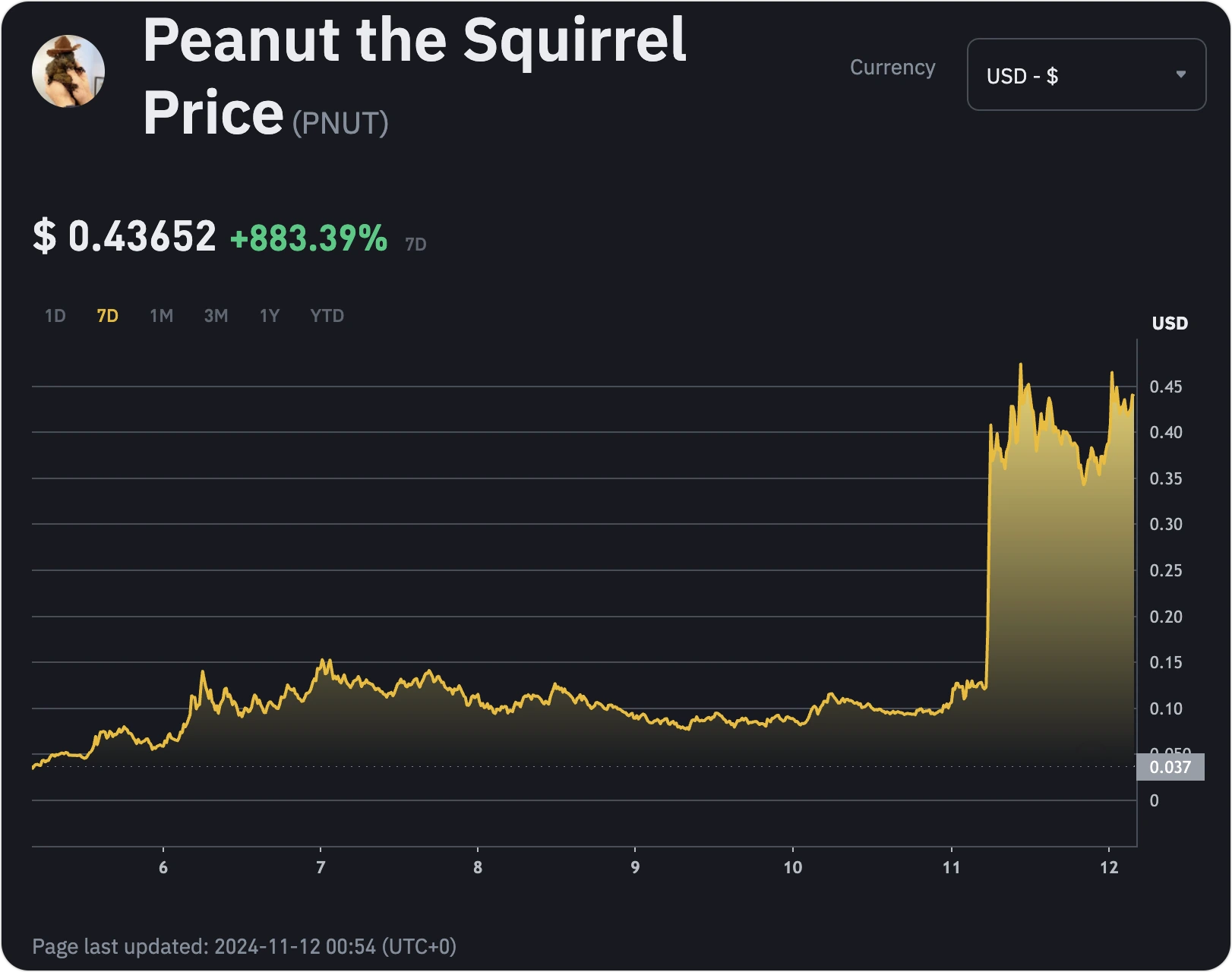
- As Bitcoin reaches new highs, lower-cost memecoins like Dogecoin, Shiba Inu, and PNUT become popular investment choices for retail traders seeking quick profits.
- Memecoin prices are highly volatile and are often driven by internet memes and social media hype, with significant price swings influenced by mentions from high-profile figures and media coverage.
- Early investors and creators of memecoins can see substantial returns, while retail investors face high risks, especially with the prevalence of “pump and dump” schemes.
TABLE OF CONTENTS

Memecoins have become significant players in the current cryptocurrency bull market, attracting retail investors seeking high returns. As Bitcoin reaches new highs, the appeal of cheaper alternatives like memecoins grows.
MEMECOINS BEING WILDLY HYPED
Bitcoin recently reached a new all-time high of $82,000 and continued its upward momentum today, briefly hitting $90,000. This recent performance has largely validated our earlier outlook. While Bitcoin’s gains have been impressive, they seem modest when compared to the explosive growth seen in some memecoins. For example, on November 11, Act was officially listed on Binance, skyrocketing by as much as 2,400% within 24 hours and currently holding at around a 2,000% gain.

(Source: Binance)
Act’s dramatic price surge quickly turned it into a social media sensation, sparking widespread discussion. Those who were fortunate enough to ride this wave have potentially achieved financial freedom.
The AI Prophecy Project (ACT)
The AI Prophecy Project (ACT) is a decentralized, open-source platform aiming to redefine interactions with artificial intelligence. This project creates a dynamic “ecosystem” where various AI systems, powered by the ACT token, can interact with one another and engage with human users, promoting innovative and unconventional AI applications. In contrast to mainstream chatbots, which prioritize “helpfulness, harmlessness, and honesty”—as advocated by tech giants like Microsoft, OpenAI, and Anthropic—Act I encourages a more creative, open-ended approach to AI development.
This is how Act describes itself. Although the project’s ambitions are impressive, we still have some reservations about its future prospects.
The Rise of PNUT
Besides Act, another standout in recent days has been Pnut, which has seen a seven-day increase of 880%, far outpacing mainstream cryptocurrencies like Bitcoin.

(Source: Binance)
What is Peanut the Squirrel (PNUT)?
Peanut the Squirrel (PNUT) is a memecoin launched on the Solana blockchain. Peanut became an internet icon through a series of heartwarming posts by his caretaker, Mark Longo, who showcased Peanut performing tricks and wearing miniature hats. On October 30, Peanut was seized by authorities, and he was subsequently euthanized. This event sparked significant public outcry and led to the creation of the PNUT memecoin in his memory.
Notable figures, including Elon Musk and Congressman Nick Langworthy, publicly condemned the authorities’ actions. Musk’s posts on X (formerly Twitter) brought even more attention to the story, boosting PNUT’s popularity and attracting considerable investment from the cryptocurrency community.
WHAT DRIVES MEMECOIN RALLIES?
Memecoins are cryptocurrencies inspired by jokes or famous internet memes. The original memecoin, Dogecoin, is based on a Shiba Inu meme. Newcomers like Dogwifhat and Pepe feature a dog wearing a hat and a green, anthropomorphic frog, respectively. Technological differences exist among memecoins, but Dogecoin remains the most prominent, with a market cap exceeding $22 billion. Other well-known memecoins include Shiba Inu, Pepe, Bonk, Dogwifhat, and FLOKI. Most memecoins are worth less than a penny per token.
Compared to Dogecoin, newer memecoins tend to have more grassroots origin stories. While Dogecoin gained fame through celebrity endorsements, notably from Elon Musk and Dallas Mavericks owner Mark Cuban, most other memecoins lack such high-profile backing.
Memecoins lack traditional fundamentals, but their low prices can offer the allure of quick, substantial returns. Memecoin frenzies often emerge after significant Bitcoin rallies. As Bitcoin becomes increasingly expensive, memecoins offer a more affordable investment option for retail traders. In nearly every cryptocurrency bull market, at least one popular memecoin tends to emerge, such as DOGE, WIF, PEPE, and RATS.
Many memecoins also have questionable token distribution, where a large portion of tokens is held by a small group of investors. This allows large holders to influence memecoin prices more easily. Additionally, due to memecoins’ smaller market caps compared to Bitcoin, their prices can be highly sensitive to specific events. For instance, Shiba Inu’s price surged in 2022 after Robinhood announced it would add the token to its platform.
WHO WINS AND WHO LOSES?
Early investors who bought memecoins at nearly zero stand to make the biggest profits in the memecoin market. The creators and developers of memecoins are also winners, especially when they retain a large share of the tokens. Crypto exchanges and brokerages benefit as well, seeing increased trading volume and fee revenue when interest in memecoins spikes.
However, retail investors are often at risk when buying memecoins without fully understanding them. Some memecoins carry high risks of “rug pulls,” where developers suddenly withdraw liquidity, leading to a sudden price crash.
Read More:
CoinRank’s Market Watch: From Meme Evolution to AI Innovation – FLOKI, BCH, APT, and WLD Analysis
Runes, the New Protocol on Bitcoin Blockchain You Should Know About
CoinRank x Bitget – Sign up & Trade to get $20!






















